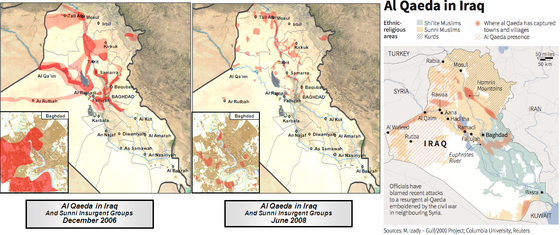The Islamic State of Iraq and the Sham, an al Qaeda branch in the Middle East, and its tribal allies have taken control of Fallujah less than one week after launching an offensive in Iraq's western province of Anbar. Meanwhile, the military and tribes that oppose the ISIS have launched counterattacks in Ramadi and other cities and towns along the Euphrates River.
Security officials and reports told the BBC that the ISIS fighters "control the south of the city," while "tribesmen allied with al Qaeda hold the rest of Fallujah." Reuters reported that "the northern and eastern parts of the city were under the control of tribesmen and militants."
The names of the tribes that are supporting al Qaeda have not been disclosed. During the height of al Qaeda's power in Fallujah, from 2004 to 2007, the Zobai and the Fuhaylat sub-tribe of the Albu Issa backed al Qaeda in Iraq, the predecessor of the ISIS.
Jihadists waving al Qaeda's black flag have occupied police stations and government buildings, and are issuing calls from mosques for men to join the fight against the government.
The military has responded by shelling areas of the city under ISIS control. The total number of people killed during the fighting in Fallujah is not yet known.
ISIS fighters seized control of parts of Fallujah and Ramadi, the two largest cities in Anbar, on Tuesday after the Iraqi military withdrew from the cities in the wake of clashes between government forces and the tribes following the arrest of a senior Sunni politician in Ramadi. [See LWJ report, Al Qaeda seizes partial control of 2 cities in western Iraq]. Maliki ordered the troops to return to the cities after cutting a deal with the tribes, but not before the ISIS quickly moved in and seized control.
Fallujah and Ramadi were considered the seats of al Qaeda in Iraq's power from 2004 to early 2007. Large areas of the two cities were either controlled by al Qaeda or were contested. The Awakening and US and Iraqi forces waged a protracted counterinsurgency to clear al Qaeda from the two cities as well as from surrounding cities and towns along the Euphrates River Valley.
Fighting continues in Ramadi and elsewhere in Anbar
In Ramadi, ISIS fighters still control areas in the city, but the Iraqi military and Sunni tribes are battling to regain control of the lost neighborhoods. A senior Iraqi general told AFP that 25 ISIS fighters have been killed during an operation. Yesterday, an ISIS commander known as Abu Abelrahman al Baghdadi, who is thought to be the group's emir in Ramadi, is said to have been killed during the clashes.
Fighting in other areas of Anbar has been reported. The Iraqi general claimed that "a large gathering of [ISIS] members was targeted" near the town of Karma, and that 30 ISIS fighters were killed. Karma, a town just east of Fallujah, was also hotly contested from 2004 to 2007.
Outside of Fallujah, the Iraqi tribes appear to be organizing to fight the spread of al Qaeda. The head of the Dulamyi tribal confederation "has called on all tribes in Anbar to carry weapons and stand beside the Armed Forces to combat the remnants of the terrorists al Qaeda and the ISIS, protect police centers and expel terrorists from them, and give information about infiltrators among the tribes," according to a Jan. 2 report on Al Iraqiya TV.
Iraqi tribes and the military are also said to be organizing to launch operations to clear the cities and towns of Rawa, Anah, Haditha, and Al Qaim.
Al Qaeda regaining control of areas in Iraq it lost during the surge
The ISIS has had success in regaining control of areas of Iraq that it lost during combined US and Iraqi counterinsurgency operations from 2007 to 2009. A map recently produced by Reuters shows that the ISIS controls villages and towns along the Euphrates River and the border with Syria as well as in the desert in Anbar, in areas south of Baghdad, in the Hamrin Mountains in Diyala and Salahaddin, and in numerous areas in Ninewa [map is below].
When the Reuters map is compared with maps produced in 2008 by Multinational Forces - Iraq that show al Qaeda control in Iraq in 2006 [leftmost map] at the height of the organization's strength in the country, and 2008 [center map] after the group was driven from many of its sanctuaries, al Qaeda's resurgence becomes clear.
The ISIS began retaking control of areas in Iraq after the US withdrew military, intelligence, and logistical support from the Iraqi military and intelligence services and abandoned its support of the Awakening in December 2011. The Syrian civil war and a political standoff between Prime Minister Maliki and Sunnis in Anbar have also fueled the resurgence of al Qaeda in Iraq.
In Syria, the ISIS and the Al Nusrah Front for the People of the Levant, al Qaeda's other branch in Syria, and allied Islamist groups from the Islamic Front control large areas in the northern and eastern portions of the country.

